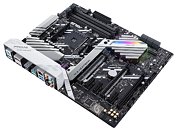Sunday, June 2nd 2019

AMD 300-series and 400-series Motherboards to Lack PCIe Gen 4 with Ryzen 3000
This shouldn't really need to be spelled out, but AMD clarified that you can't have PCI-Express gen 4.0 running an upcoming Ryzen 3000 "Matisse" processor on older socket AM4 motherboards based on AMD 300-series and 400-series chipsets, and that the processor's PCIe root-complex will run at PCI-Express gen 3.0 speeds. AMD's official reason for this is that the older motherboards can't guarantee reliable signaling needed for PCI-Express gen 4.0 and hence the company decided to blanket-disable PCIe gen 4.0 for the older platforms. This statement was put out by Robert Hallock, senior technical marketing head for CPUs and APUs, on Reddit.
Unofficially, though, we believe there are technological barriers standing in the way of PCI-Express gen 4.0 on the older motherboards, the least of which are the lack of external PCIe gen 4.0-certified re-driver/equalizer components, and lane-switching on boards that split one x16 PEG link to two x8 links. There may be other less technical issues such as PCI-SIG certification for the older platforms. Intel faced a similar challenge with its 3rd generation Core "Ivy Bridge" processors, which introduced PCI-Express gen 3.0 to the mainstream desktop platform, and were backwards-compatible with Intel 6-series chipset (eg: Z68 Express). The older 6-series motherboards could only put out PCIe gen 2.0 with the newer processors.
Source:
Robert Hallock (Reddit)
Unofficially, though, we believe there are technological barriers standing in the way of PCI-Express gen 4.0 on the older motherboards, the least of which are the lack of external PCIe gen 4.0-certified re-driver/equalizer components, and lane-switching on boards that split one x16 PEG link to two x8 links. There may be other less technical issues such as PCI-SIG certification for the older platforms. Intel faced a similar challenge with its 3rd generation Core "Ivy Bridge" processors, which introduced PCI-Express gen 3.0 to the mainstream desktop platform, and were backwards-compatible with Intel 6-series chipset (eg: Z68 Express). The older 6-series motherboards could only put out PCIe gen 2.0 with the newer processors.

62 Comments on AMD 300-series and 400-series Motherboards to Lack PCIe Gen 4 with Ryzen 3000
Since AMD has goodwill and knows to keep their board vendors happy (vs the messy Ryzen 1000 launch), AMD will take the minor PR hit. Win win for everyone, except for the consumer (who will self police, anyways).
Also, Gigabyte already thought otherwise, and will be reversing their decision (as noted by the quote itself, of course).
Wasn't x470 pcie 2.0 too?
We all know how motherboard manufacturers handling things.
If they really put PCI-E 4.0 bios updates to older chipsets, expect your PCI-E devices to be unstable for at least 1 or 2 bios revisions.
Better not doing that.
There were a couple demoed at ces in jan running pcie 4 on their x470 boards.
Cheaper boards are often only four layers, whereas higher-end boards are six or even eight layers. This allows for much beter signal integrity as well.
Then you have the type of PCB design that's employed. Apparently PCIe 4.0 based boards use improved materials and you can find some details about the various options available here (it's a tad old, but still kind of relevant to the topic) www.lboro.ac.uk/microsites/research/iemrc/documents/EventsDocuments/2012 conference/presentations/A Morgan Low Loss High speed laminates - What is really needed.pdf
Then there's the "eye" diagram, you'll also find that in the PDF linked above. This is a standard test for signal quality and if the eye part isn't even or open enough, then your implementation doesn't meet the signal quality required. I would guess this is a big issue on older PCB designs that didn't take into consideration the possibility of a higher speed signal being passed through the board traces when these PCBs were designed. No-one tends to design these things for a possible future standard, so it's just done to a satisfactory level for the current technology available.There will be SSDs by the time the boards launch, but I guess you didn't read any of the Computex coverage on this site?
I will have to wait reviews x470 x x570 and if there is a speed difference between them, memory wise which tends to contribute a lot on the final ipc.
It is motherboard manufacturers responsibility to verify whether the physical layer they provide complies to signaling requirements or not.
Such step by AMD shows that they do not believe that MB makes can competently validate their own products, i.e. would cut corners or just enable 4.0 with no checking at all.
They still have more coming, as I bumped into them at a few manufacturers that haven't been covered yet.I'm also sure a lot of those products weren't certified...
There's a difference between a cheap accessory and something that has to be certified or you can't sell it.
You might be right there. Big difference between the tier one guys and the rest...